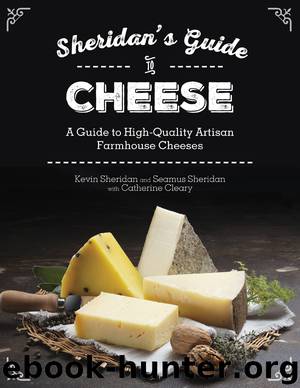Sheridans' Guide to Cheese by Kevin Sheridan

Author:Kevin Sheridan
Language: eng
Format: epub
Publisher: Skyhorse Publishing
Published: 2016-03-24T16:00:00+00:00
In cloth-bound Cheddars, the odd small blue vein running a few inches into one of these cheeses, particularly the more mature ones, is a lovely indicator of a cheese with a natural rind. However, if that small vein grows into a web of blue by linking with tiny cracks and fissures throughout the body of the cheese, it can be a problem. Some customers enjoy the resulting flavour but most prefer their Cheddars white (or red) and their blues blue. These blue veins are a result of small cracks that occur when the cheese dries out too quickly. This veining can be made much worse if the cheeses are not treated gently in the maturing rooms. When turning the cheeses, it is very easy to bang the heavy rounds back on to the boards. This sends little shockwaves through the cheese and any small blue veins will expand through the newly created highways. To reduce drying out and the resulting cracks, cheesemakers can increase the amount of lard applied. But if too much is applied, the cheese seals almost completely and the result can be worse. Without the ability to breathe out moisture, the cheeses become rubbery and the flavour does not develop properly. It’s a delicate balance.
RED LEICESTER, RED CHESHIRE, RED CHEDDAR. WHAT MAKES THE CHEESE RED?
LIKE RED LEMONADE, red Cheddar is a favourite with Irish consumers. We’ll fairly frequently hear a new customer looking for red Cheddar: ‘I much prefer red Cheddar,’ they’ll say.
The red dye in Cheddar and other cheeses does not affect the flavour. It is a tasteless food colouring, typically annatto, which comes from the skin of the deeply coloured seeds of the tropical achiote tree. On Irish supermarket shelves there are always two Cheddars, red and white. The colour is the only difference. In a blind test both cheeses taste exactly the same. We eat with our eyes first and so it makes sense that the colour of a cheese makes a difference to us, though.
Colouring cheese goes back a long way. It’s believed that Cheshire cheesemakers colour-ed their cheaper, lower fat cheeses with carrot juice in the seventeenth century to make them look more alluring (traditionally a richer, more yellow cheese is generally higher in fat content and has more carotene, which comes from fresh grass rather than other feeds). When they sent these inferior cheeses to market, they found the coloured cheeses sold even better than the higher quality, full-fat cheeses and so more and more cheesemakers began to dye cheese a richer colour.
Download
This site does not store any files on its server. We only index and link to content provided by other sites. Please contact the content providers to delete copyright contents if any and email us, we'll remove relevant links or contents immediately.
| Appetizers | Breakfast |
| Brunch & Tea | Burgers & Sandwiches |
| Casseroles | Garnishes |
| Pizza | Salads |
| Sauces & Toppings | Soups & Stews |
Panini by Carlo Middione(3252)
Sauces by James Peterson(3051)
Best of Jane Grigson by Jane Grigson(2947)
Tapas Revolution by Omar Allibhoy(2929)
Better Homes and Gardens: Wonder Pot by Better Homes & Gardens(2033)
The Anne of Green Gables Cookbook by Kate Macdonald(2019)
Project Smoke by Steven Raichlen(1999)
Salad Days by Pam Powell(1915)
Rise and Shine by Katie Sullivan Morford(1864)
Food Processor Perfection by America's Test Kitchen(1826)
Fabulous Party Cakes and Cupcakes by Carol Deacon(1806)
The Soup Mix Gourmet by Diane Phillips(1763)
The Salad Garden by Joy Larkcom(1720)
America's Best Ribs by Arthur Aguirre(1635)
Mouthwatering Vegan Burgers by Becky Lawton(1627)
The Jam and Marmalade Bible by Jan Hedh(1619)
America's Best Barbecue by Arthur Aguirre(1608)
The Perfect Egg: A Fresh Take on Recipes for Morning, Noon, and Night by Teri Lyn Fisher & Jenny Park(1575)
Good Food to Go by Brenda Bradshaw(1525)
